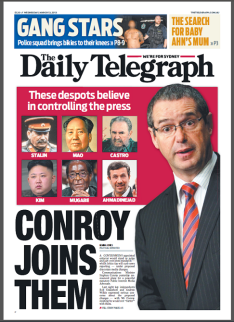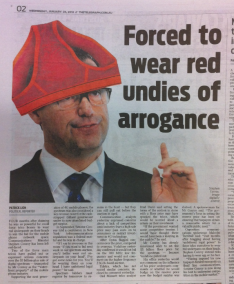Conroy’s legacy
 Last week Stephen Conroy, minister for broadband, communications, and the digital economy stepped down after five years in the role. But what mark has he left on the media industry? In a piece that first appeared in Encore, Megan Reynolds investigates.
Last week Stephen Conroy, minister for broadband, communications, and the digital economy stepped down after five years in the role. But what mark has he left on the media industry? In a piece that first appeared in Encore, Megan Reynolds investigates.
He’s been compared to Hitler, Stalin and Mao, while others have praised him for breaking ground on the national broadband network and established monopolies on telecommunications and broadcasting rights. The man behind the media, Stephen Conroy, last week stepped down from his role as the minister for broadband, communications, and the digital economy, after five and a half years in a job that both gave him power over the media and left him paralysed without its support.
Conroy’s lasting mark on the media could have been the Finkelstein inquiry, an independent investigation he ordered into media regulation that called for a new government-funded body to oversee the print, online and broadcast media. But the findings divided both journalists and politicians and were swallowed by the much larger convergence review that looked at broader issues around the digitisation of the media landscape.
Fairfax and News Limited strongly opposed the resulting media reforms and nothing was made of them for more than a year until Conroy proposed a package of six non-negotiable bills in March and called for them to be voted on within ten days.
The reforms included the introduction of a public interest test to ensure diversity in media mergers and acquisitions, and strong self-regulation of print and online news.
But just two of the bills were passed – those deemed least controversial – covering a mandated increase in Australian content production, the prevention of a fourth commercial television network, and a requirement for the ABC and SBS to produce online content. As the bills were laid on the Parliamentary agenda, Conroy appeared on the front page of Sydney’s Daily Telegraph alongside the dictators Stalin, Mao, Castro, Kim Jong Un and Mahmoud Ahmadinejad of Iran.
Paul Whittaker, the newspaper’s editor tells Encore: “We compared him to Stalin, not because we were suggesting he was literally as bad as a mass murderer, only that he shared similar views on controlling the press.”
“By using that stark example, we put a serious matter the government was trying to sneak under the radar front and centre in the national debate.”
Professor Wendy Bacon, former head of the journalism school at the University of Technology Sydney and contributor to the Finkelstein inquiry, says Conroy was “spooked” by News Ltd, and missed an opportunity for media reform.
“Stephen Conroy could have left a legacy of media reform but unfortunately he didn’t,” she told Encore.
“It was a disappointing shambles and there won’t be a chance in a long time to tackle unacceptable and damaging levels of concentration in media ownership in Australia.
“The reform package he came up with needed to be negotiated and to have input from the Greens and Independents but he just did not allow the time for that.”
Conroy also failed to take up initiatives put forward by academics and journalists to introduce incentives such as tax breaks to support investigative and in-depth journalism in poorly served regional areas, Bacon says, however one reform he did push through was reduced rate free-to-air TV licenses which were warmly received by the commercial networks. “He appeared to want the green light from the media companies,” says Bacon.
“At the end of the day, I think the problem was that Conroy didn’t have a feel for media and any reform was going to exceptionally tough because the media proprietors and executives could campaign against any change that affects their interests.”
Whittaker says that as Conroy invested a huge amount of energy and time in his “so-called media reforms” they also demanded a massive amount of time and energy from many other interested parties.
“Conroy’s approach to the media can be summed up in one word: anti. Except if you are Channel Nine or the ABC,” he claims. “He demonstrated a fundamental lack of understanding about how the media works, an open hostility towards it and came dangerously close to straight-jacketing journalism in this country. In the end, however, he essentially gave it all up by presenting the bills to Parliament as a fait accompli which also alienated sections of his own party. His legacy might be that a lot of work was undertaken simply to get us back to where things were originally.”
 Conroy will also be remembered for being mocked in The Daily Telegraph wearing a pair of red underpants on his head after he told a conference in New York about his federal power over telecommunications regulation.
Conroy will also be remembered for being mocked in The Daily Telegraph wearing a pair of red underpants on his head after he told a conference in New York about his federal power over telecommunications regulation.
“If I say to everyone in this room ‘if you want to bid in our spectrum auction you’d better wear red underpants on your head’, I’ve got some news for you. You’ll be wearing them on your head,” Conroy said.
In another bid to exercise his power, this time over the internet, Conroy was awarded “Internet villain of the year” by the Internet Industry Awards in the UK in 2009. The minister had proposed policies to restrict access to online content that were initially said to block illegal material such as child pornography and sexual violence, but were extended to a whole range of legal websites blacklisted by the Australian Communications and Media Authority (the ACMA) and revealed by WikiLeaks in March 2009.
But for all the antagonism Conroy faced, Harold Mitchell, founder of Mitchell and Partners and executive chairman of Aegis Media Pacific, limits his comments on Conroy’s legacy to just one glowing point. “In my dealing with him, he enabled SBS to come to an arrangement to cover soccer and he approached the job with great zeal and energy,” he said. “Soccer is now on free to air TV as well as on Foxtel. For me, that’s it.”
And when it comes to the development of the digital media landscape, John Butterworth, CEO of Australia’s digital industry association the AIMIA, believes Conroy made great progress.
“In the digital world he’s had a massive impact. He was devoted to digital as part of his portfolio but was also interested and made an effort to understand what was going on,” he says.
“As an industry body there are things we disagreed with Stephen Conroy about – media regulation and filtering and that sort of stuff – but equally it was good to be able to have a conversation with someone who really understood there was a digital economy coming up.”
Butterworth remembers Conroy arriving unannounced at an AIMIA drinks party in a pub one night.
“Instead of being the grey-suited telecommunications minister he was different,” Butterworth said.
“He just turned up at a pub and I got to switch my speech halfway through to welcome the honourable Stephen Conroy who I had just spotted at the back of the room.
“Personally I am sorry to see him go. He’s always taken a direction.”
Conroy also led the digital TV switchover across the country which is due to be completed by the end of the year. And his rollout of the NBN has broken Telstra’s historic dominance of the telecommunications sector and opened opportunities for competitors.
Phil Ruthven, founder and chairman of market research firm IBISWorld, says Conroy’s plans for the NBN have been critical for Australia despite the negative press the estimated $38bn price tag for the scheme has attracted.
“Conroy was pushing something that I think should be regarded as a non-negotiable infrastructure component for Australia,” he says.
“I think the great tragedy is that too much publicity has been given to the figure of $38bn – it’s really chickenfeed compared to what it cost to get electricity or telecommunications in Australia for the first time.
“The only valid disappointment would be that it seems to be rolling out slower than everybody had hoped it would, but I can’t think of any private system that has been on time or on price either.”
Ruthven feels Conroy was committed to his plan for the NBN and understood the long term ramifications of fast broadband far better than the opposition. The less expensive alternative put forward by shadow minister Malcolm Turnbull to install fibre optic cables to the nearest corner or node and then run it through the existing copper wires to properties is a “half-pregnant solution”, Ruthven says.
“I don’t think people understand how vulnerable the Australian economy is without fast broadband going into the rest of this decade, it just absolutely astonishes me,” he told Encore.
As Conroy departs before the general election, Ruthven hopes his plans for the NBN will at least be investigated to ensure the best broadband plan for Australia is implemented.
Conroy’s legacy, on balance was “a lot more positive than negative,” Butterworth says. Ruthven agrees.
And while Whittaker stands by The Daily Telegraph front page of Conroy and the dictators, he says there is a silver lining to Conroy’s time in office.
“He made one very positive and significant contribution, although he didn’t intend to do so,” he said.
“By pursuing his so-called media reforms, he alerted Australians to issues of freedom of speech that many of us take for granted.
“We’ve probably had more discussion about freedom of speech in Australia over the past couple of years than we have in the two decades previously, all thanks to the Senator’s zeal.”
 This story first appeared in the weekly edition of Encore available for iPad and Android tablets. Visit encore.com.au for a preview of the app or click below to download.
This story first appeared in the weekly edition of Encore available for iPad and Android tablets. Visit encore.com.au for a preview of the app or click below to download.




“Australia does not have explicit freedom of speech in any constitutional or statutory declaration of rights, with the exception of political speech which is protected from criminal prosecution at common law per Australian Capital Television Pty Ltd v Commonwealth.”
http://en.wikipedia.org/wiki/F.....#Australia
It’s amazing what ten seconds on a search engine will get you.
User ID not verified.
Thank God Steve Conroy is out…he is so far removed from the digital landscape it was ridiculous.
User ID not verified.
Like the rest of the Labor team, he couldn’t manage a chook raffle in a country pub. His legacy will be enormous debt. The NBN is a disgrace, it is behind its own deadlines, over budget and most probably technology out-of-date before it gets connected to any significant number of homes. Just another giant stuff-up by this inept group of fools, and in this case Conroy.
User ID not verified.
@ wang
I’m glad to see the end of Conroy but saying the NBN is a huge disgrace, well thats a bit harsh.
It will be out-of-date?, I’m assuming you’re not an IT infrastructure expert, neither am I so lets trust the one in the know and they seem to think that fibre optics is the way to go, and please note your post was delivered by a copper network that has lasted 100 years, its in bad shape to be sure, but to say a new network will be out-of-date before its finished, well you really should go back to writing fairytales or work as Tony Abbott’s speech writer.
Being over budget and slow to deliver, well sheez show me a nationwide project that wasn’t hell the article even addressed that….
“The only valid disappointment would be that it seems to be rolling out slower than everybody had hoped it would, but I can’t think of any private system that has been on time or on price either.”
I’m gonna defend the NBN and say its Conroys only saving grace.
Side note, I’m on Telstra cable, its the closest thing to the NBN and personally I wouldn’t go back to ADSL, We can have the whole family streaming youtube at High Def and no one has disconnections, slow buffering or dropouts….try that on your copper network!
User ID not verified.